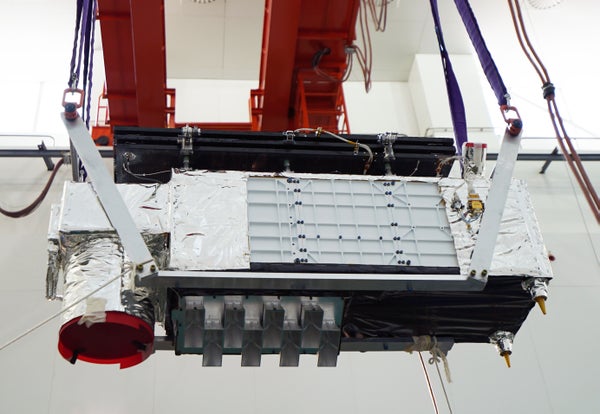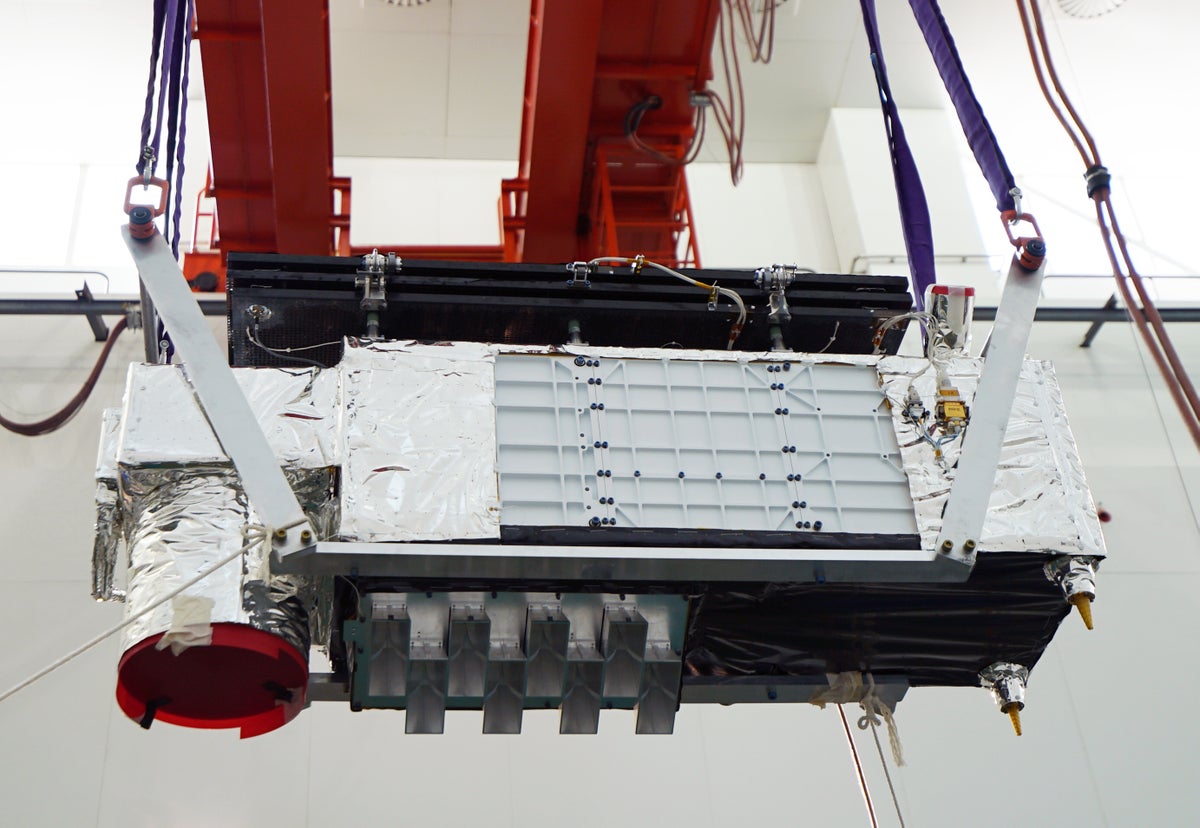Mini-Satellite Sends Encrypted Quantum Message a Record-Breaking Distance
Scientists in China have transmitted encrypted images a record 12,900 kilometers, paving the way for quantum messaging anywhere on Earth

The fridge-sized satellite Jinan-1, pictured before its launch in 2022.
Researchers have broken a distance record in quantum communication by sending a secret encryption key nearly 13,000 km from China to South Africa, using a cheap, lightweight ‘microsatellite’.
The satellite was able to send pulses of laser light, put into special quantum states, from a rooftop in Beijing to another at Stellenbosch University near Cape Town. The pulses formed a quantum key that was used to encrypt two images — one of China’s Great Wall and one showing part of Stellenbosch’s campus. The feat, a kind of encryption known as quantum key distribution (QKD), is a step towards being able to send ultra-secure messages between any two locations, however distant. It was described in Nature on March 19.
The satellite, called Jinan-1, is ten times lighter, 45 times cheaper and much more efficient than its predecessor, Micius, which launched in 2016, says Jian-Wei Pan, a quantum physicist at the University of Science and Technology in Hefei, China, who led the work.
On supporting science journalism
If you’re enjoying this article, consider supporting our award-winning journalism by subscribing. By purchasing a subscription you are helping to ensure the future of impactful stories about the discoveries and ideas shaping our world today.
Pan’s team also shrank the ground-station receiver from 13,000 kg to a portable 100 kg. “We want to improve the technology from proof-of-principle to really practical and useful,” he says. Pan adds that his team is working with the Beijing-based telecommunications firm China Telecom to launch four more microsatellites for commercial applications in 2026.
“This is another milestone in the development of a global QKD network,” says Alexander Ling, a quantum physicist at the National University of Singapore. The satellite is “a significant step forward” in deploying this kind of encryption in real time, adds Katanya Kuntz, a quantum physicist and co-founder of Qubo Consulting, a firm based in Calgary, Canada, that helps other companies to adopt quantum technologies.

Researchers encrypted these two images using a quantum key, which they transmitted from China to South Africa.
University of Science and Technology of China
Uncrackable codes
Physicists think that future quantum computers will be able to break many types of encryption, but techniques such as QKD provide “very strong assurance that a future quantum computer cannot read confidential communications”, says Ling.
QKD is already used by banks and governments to transmit keys over fibre optics. But these cables absorb photons, limiting the distance over which the signal can travel. Because light is absorbed at a much lower rate when travelling through the air than in a fiber-optic cable, satellites could act as a relay to send secret keys between two locations almost anywhere on the planet.
Quantum encryption rests on the idea that if two parties share a secret key, they can scramble a message so that only they can decode it.
Pan’s experiment involved sending pulses of laser light that are each in a ‘superposition’, where they exist at once in two quantum states, representing 1 or 0. By comparing the settings that the sender uses with those used by the receiver to measure the pulses, the two parties can work out a selection of measured 1s or 0s to use as a secure key. If an eavesdropper tries to intercept the message, this disturbs the quantum states and creates noise, revealing that the key has been compromised.
Faster communication
The set-up involving Jinan-1 includes “several impressive technological accomplishments”, says Kuntz, who is a member of the science team for the Quantum Encryption and Science Satellite, a QKD satellite due to be launched next year by the Canadian Space Agency. Communication between the ground and the satellite is faster than with previous systems, which speeds up encryption, she says. The team was also able to shrink the satellite by giving some of its components two jobs, Pan notes, for example by using just one piece of kit to both aim the beam and control the satellite’s orientation.
However, Jinan-1 is not able to do everything that its chunkier predecessor could. It does not produce ‘entangled’ photons, which would enable kinds of encryption that hide the key even from the satellite. In the current system, Jinan-1 processes the key, “and an eavesdropper could learn the secret key if [they] hacked the satellite”, says Kuntz. Entanglement will also be needed to connect quantum computers around the globe as part of a quantum internet. Miniaturizing the technology for entanglement is harder, but developing microsatellites with such equipment will be “entirely feasible” in the future, says Pan.
Around a dozen quantum satellites are currently being prepared for launch around the world, says Ling, who is a co-founder of SpeQtral, a Singapore-based firm working on QKD satellites even smaller and lighter than Jinan-1. “This area is starting to see an uptick of investment and activity as companies and organizations begin to explore the possibility of a global QKD network,” he says.
This article is reproduced with permission and was first published on March 19, 2025.

